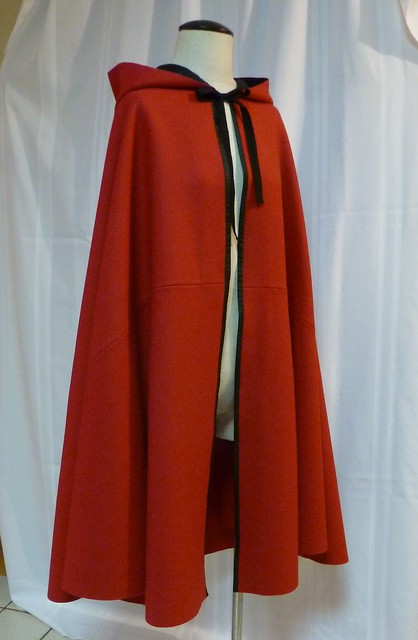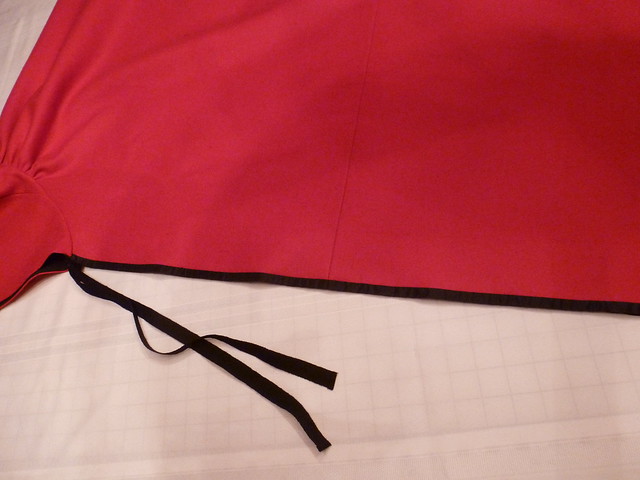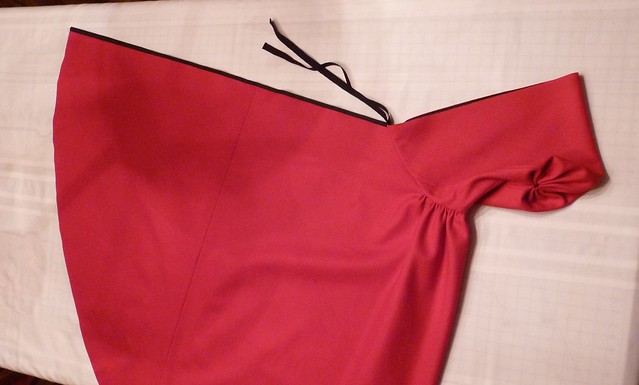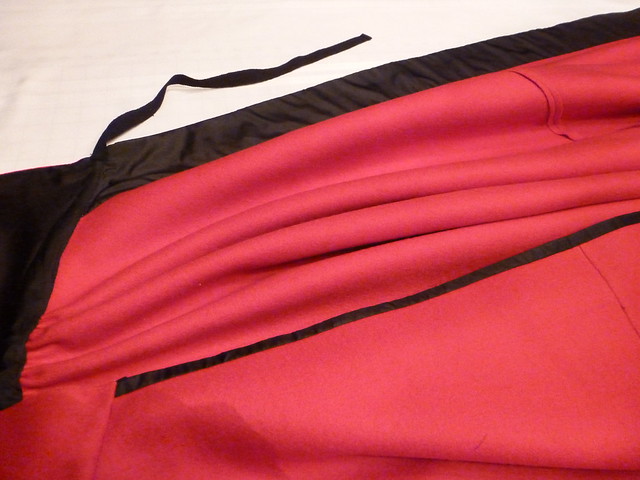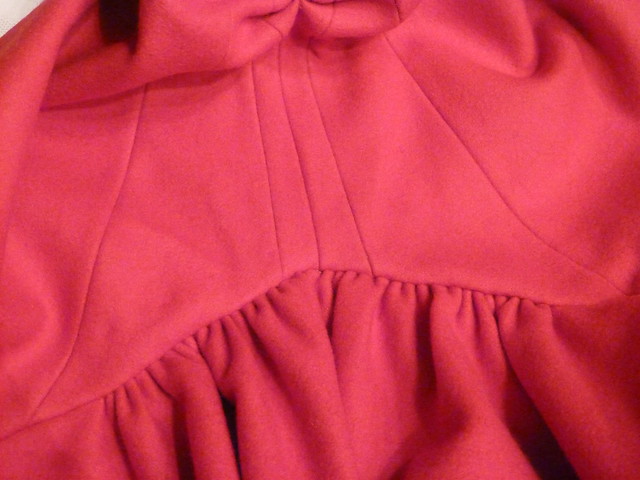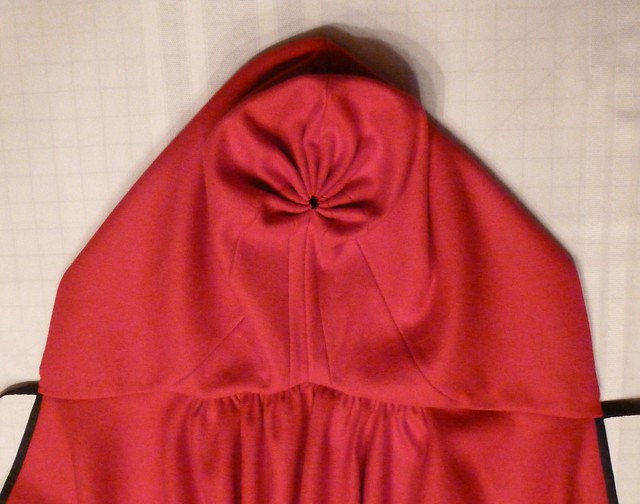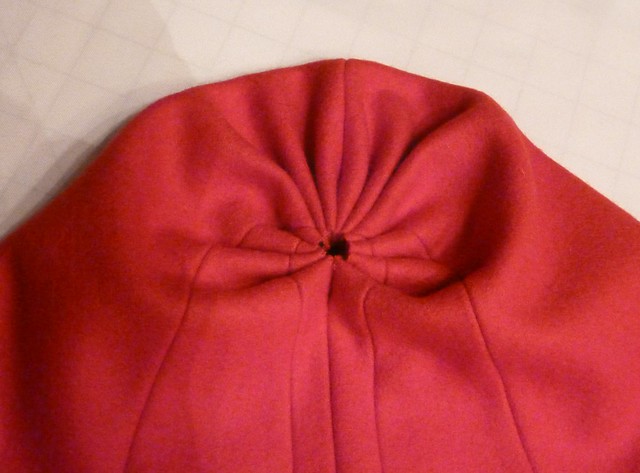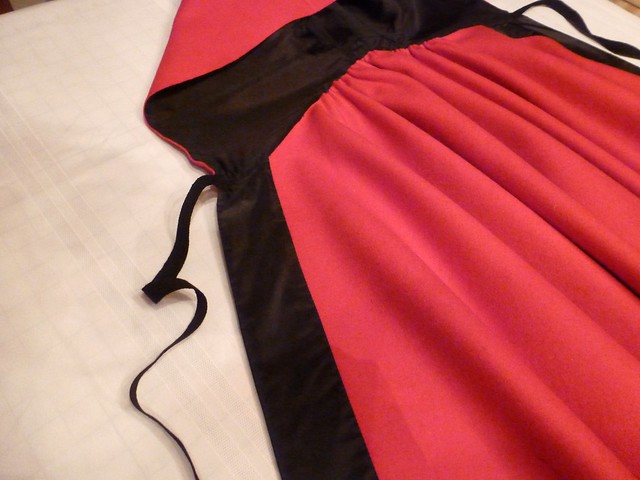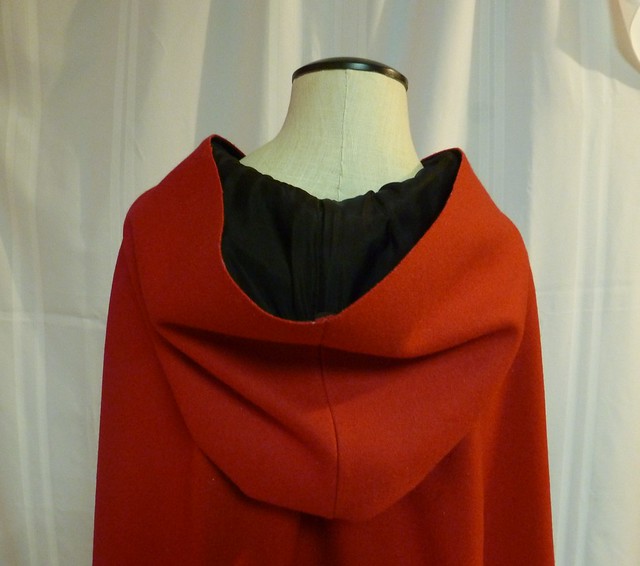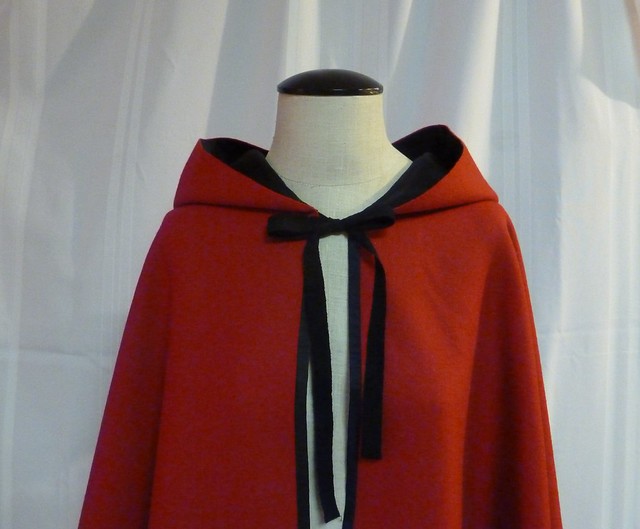A Reproduction Red Wool Broadcloth Cloak
with details taken from two extant examples
One of our friends recently joined our Rev War unit and is looking to update to her wardrobe to reflect our CT-based interpretation. She was in need of a cloak to help weather the sometimes below-freezing CT winter temperatures and knew she wanted a red one copied directly from the one featured in
Costume Close-up, since that was one of the pieces that made her first start to fall in love with 18th century fashion. So we added a couple of extra details copied from a similar extant cloak with a CT provenance and this is the end result! I'm in love and want one for myself now! :-) So here are all the nitty-gritty details:
The pattern: The pattern for this cloak is taken directly from an extant original in the collections of Colonial Williamsburg (CW acc. no. 1953-968), patterned to scale in Linda Baumgarten's indispensable
Costume Close-up, pgs. 54-56. Every detail of the construction, right down to the piecing on the hood and the body, has been reproduced, with the exception of the slits for the arms, which we left out simply because our friend didn't think she'd use them, which would render them rather counter-productive by letting the cold air in!
The cloak's source pattern and primary inspiration, a red wool broadcloth example
from the collections of Colonial Williamsburg (CW acc. no. 1953-968).
Inspirations: The hood lining and front facing details were inspired by the Williamsburg cloak.
Costume Close-up indicates that "originally, the hood was lined with with soft thin silk and the cloak front was faced with taffeta; there was not a full lining." What isn't specified, however, is the color of the original hood lining and front facings, so I turned for further inspiration to another cloak source which I had the opportunity to examine in person last year, this one with the requisite CT provenance! Similar in cut and construction to the CW example, this second inspiration cloak owned by the
CT Historical Society features the same hood lining and front facing details that Baumgarten cites - and in a very striking black!
The second inspiration cloak, this one from the
CT Historical Society (CHS acc. no. 1972.3.1).
The hood of the CHS cloak is half-lined in a thin black silk. The front opening edges of the cloak's body are bound and faced with strips of black silk which are sewn on in such a way that only a narrow band of black is visible from the outside, and a much wider band of 2 5/8" on the inside. These details were translated onto my reproduction.
Construction details: The cloak is entirely hand-sewn in a golden-brown silk thread, which reproduces the thread choice on the extant CW piece.
What I find so fun and exciting about cloaks - which otherwise might appear pretty boring to make! - is how ingenious they are when it comes to piecing in order to make the most out of the least amount of fabric. Baumgarten estimates that the CW cloak was cut from 2 3/4 yds of 55", which is pretty spot-on; mine ended up taking almost exactly that same length out of 58" width broadcloth.
The cloak's body was cut to make use of the full width of the original 55" fabric. Because my fabric was a touch wider, I of course had to trim off the leftover width on both sides to maintain the measurements and proportions of the original. To complete the full half-circle sweep, the sides are then pieced onto the central body in long, backstitched seams.
The piecing of the cloak's wide body falls at about half-way down the center front.
The cloak's body piecing helps it achieve a generously full half-circle sweep.
Once the body seams were sewn, I then applied the black silk taffeta bindings/facings to the front edges. These serve to encase the front edges to protect them from wear and also add a bit of interest to the front of the cloak with the sharp, eye-catching contrast of color. Only about 3/8" of black is exposed on the outside, with 2 5/8" strips visible on the inside. The remainder of the cloak's edges (including the hood) are left unfinished, as per both original sources. The broadcloth is well-fulled, more than sufficient for maintaining the smooth cut edges.
The cloak half-closed (on the top) and half open (on the bottom)to show the
contrasting widths of the black silk taffeta strips that form the center-front bindings/facings.
The hood is assembled from six different pieces which were all backstitched together with narrow seam allowances to eek out as much fabric as possible. Each of the pieces was cut with the grainline going in a different direction, a feature I was also careful to reproduce as I cut them out. I wish I'd taken a picture of the hood pieces all laid out together before I stitched them because the piecing is a little tough to see on the finished hood.
Detail of the hood piecing.
The hood is then lined in a very lightweight black silk before its back seam is sewn and arranged into the characteristic "fan" pleating detail that appears on the majority of extant cloaks from this period.
The back of the hood, with the signature "fan" pleating.
Finally, the hood is sewn to the body of the cloak. The gathering of the cloak's wide body is concentrated at the center back to allow the cloak to drape gracefully over the shoulders.
The cloak folded in half to show the concentration of pleats at the back of the cloak,
with the front half of the hood joined smoothly to the body.
The cloak spread flat, shown from the outside/back.
The hood lining is used to cover the neckline seam, black wool tapes are added for ties, and then the cloak is finished!
Interior of the cloak.
The hood view from the back when worn, with the black lining providing a
strikingly eye-catching contrast to the red.
Black wool tape is used for the ties, which help support the weight of the cloak when worn.
The fabric: The red wool is a superfine broadcloth of a heavily fulled weight from
Burnley and Trowbridge. It's some of the nicest quality broadcloth I've ever worked with (so yes, of course I had to buy some to make a cloak for myself, too!). The color is absolutely spot-on in terms of a match for the inspiration sources.
The black silk used in the hood lining and the front body facings is of two different weights to accurately reflect those used on the original CW example. The hood is lined in a very light-weight silk persian and the front openings are faced with a mid-weight silk taffeta.
Finishing the look: I guess we'll just have to wait for the cloak's first official airing before we finish this section! Stay tuned! :-)



